by: Paul Mogford
 Paul Mogford- golf architect
Paul Mogford- golf architect
The design of a golf hole is a simple process, but in many ways quite involved. In its simplest form, golf architecture is an intuitive process. It is about having an understanding, an affinity, for the natural environment. It is about being able to extract the essence of the land to best preserve, celebrate and capitalise upon its unique features. It is the distillation of the many attributes the site offers, but equally, it is about being able to turn the constraints of a site into positives. And it is often how a designer responds to these constraints where great design can come from.
This premise is no different to any other field of design or art form.
However, golf architecture also follows a scientific process. It combines the input of a number of sciences and specialities including agronomy (soils and turfgrass management), drainage engineering, irrigation design, flood modelling, flora and fauna and cultural heritage, to bring about a successful outcome.
Below we give a brief outline of some of the basic considerations in the design of a golf hole or golf course;
The Brief:
Who is the intended user?
In our view, and for the most part, golf should be designed with all standards of golfers in mind.
It should be fun, stimulating and challenging equally so for men and women of all ages and handicaps.
Too often, courses are overly long and too penal in their design.
Occasionally we are asked to cater for elite amateur and championship play - which requires a delicate balance to not overly impact regular play.
Our work for The Metropolitan Golf Club’s on their 10thhole is one example, with an overall objective to add some length and strategic interest to the hole.
In order to achieve extra length for tournament play, we removed several trees in the area of the tee, with a new tee to the rear adding some 20 metres.
In addition, the tees were shifted to the right to straighten out the overly doglegged nature of the hole.
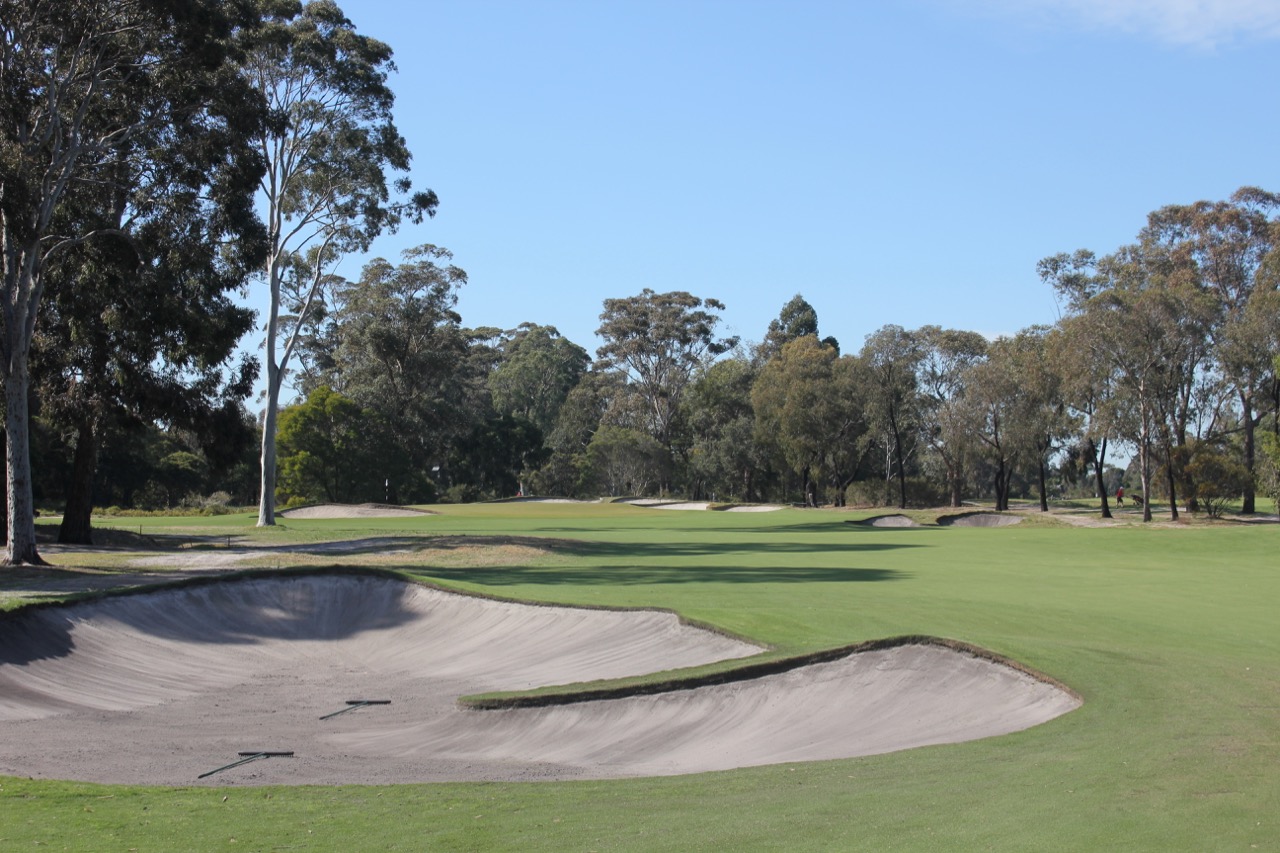 Metropolitan GC- 10th hole drive bunker
Metropolitan GC- 10th hole drive bunker
To compliment this objective, a number of trees were also removed along the left side of the fairway, which allowed for the placement of a pivotal corner fairway bunker.
From the tips this bunker is 265m to the front and around a 280m carry.
Winds from either the north or south complicate the tee shot and with driver in the hand the dam is well in range for a right hander’s block.
Importantly, from the shorter hitter’s perspective the realignment of the tees and tree removal along the left side allows much less risk of being blocked for their second shots – previously an all too common occurrence.
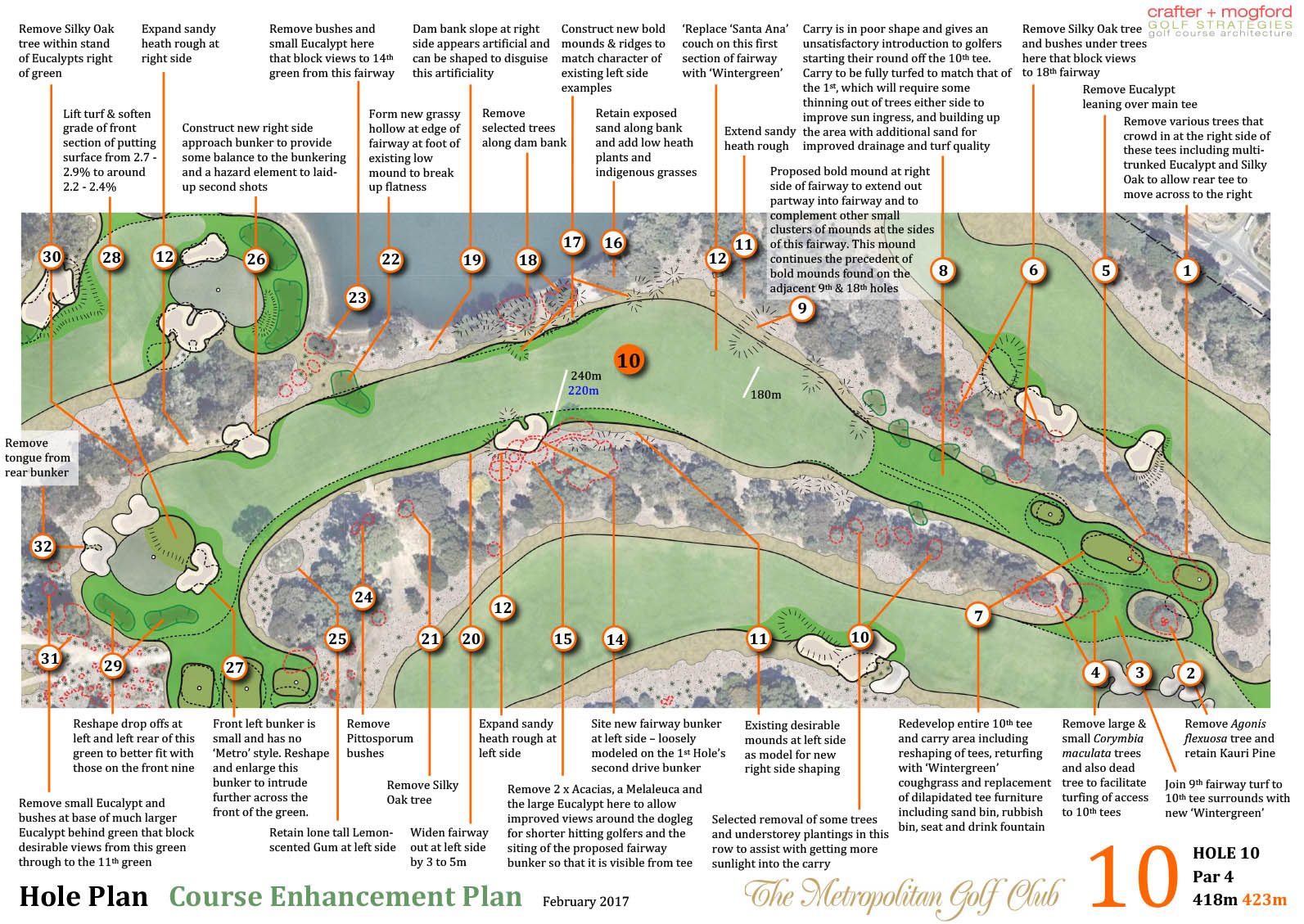
Architectural Style:
Designing a new course on a ‘greenfield’ site is quite different to undertaking modifications to an existing course.
Greenfield sites allow the architect the ultimate freedom – albeit within the constraints and opportunities of the brief.
For example, a client’s brief may be to provide a course which is focused in producing great golf holes with less regard for the conventions of par and length.
These are the enlightened clients!
Contrast this with clients who insist on a course of ‘championship’ calibre.
This is of course is fine, if it is the clients desire to produce a purpose-built course to cater for championship golf – however in reality there are few realistic opportunities in this market.
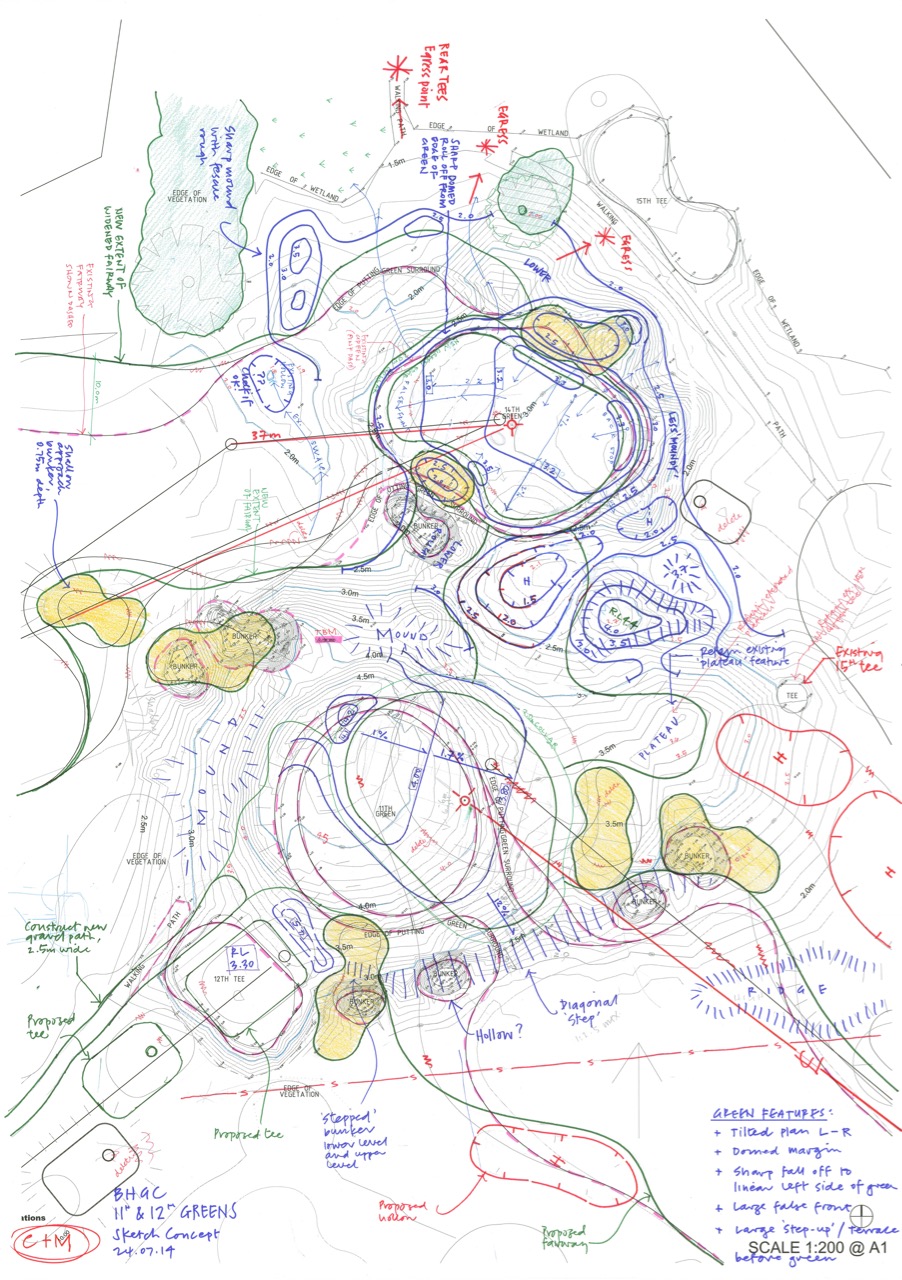 Barwon Heads GC- holes 11 & 14 Concept Sketch Paul M
Barwon Heads GC- holes 11 & 14 Concept Sketch Paul M
Existing Courses, in our view, provide the most challenging and rewarding form of golf course architecture.
This segment of the market comes in many forms.
Firstly, the ‘restoration’ - of classic courses which have had an insensitive remodeling.
Secondly, ‘course enhancements’ -where much of the course is intact architecturally and only requires a smaller number of holes to be redesigned to unite the course.
Lastly, complete ‘remodeling’ - of a course where the design was not well conceived and or constructed.
The first and second categories are where significant challenge lies as they require the greatest sensitivity and skill to bring about a successful blending of the retained desirable holes, or features, and the new.
A true measure of this success is where the ‘new’ is indistinguishable from the ‘old’.
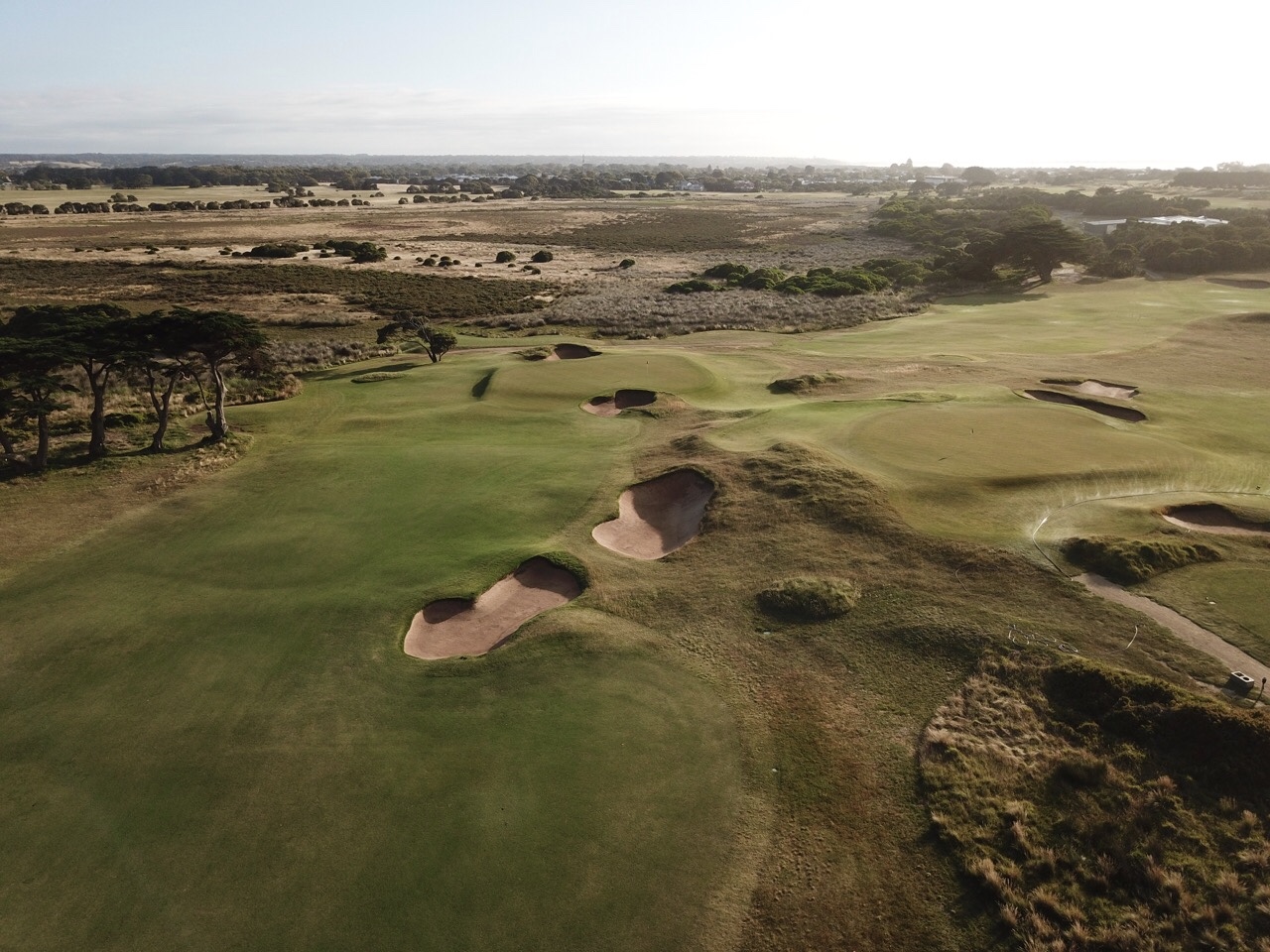
Design Strategy:
Most designers will conceive a golf hole from the green and work backwards to the tee.
Based on the size and shape the green takes, this will influence the placement of hazards and the length of a hole.
For example, if the green site suggests a small green with a fall-away nature – it will not be conducive to a long par 4 hole, but rather a short 4 or reachable par 5.
When designing a hole within an existing layout it can be important to evaluate how the proposed hole may ‘fit’ – whether it complements the balance of the par and length of holes.
For example, while somewhat of a conventional approach, a designer would generally avoid having two consecutive par 3’s and certainly not of similar length and or direction.
Site Assessment:
The topography, or ‘lay of the land’, is of primary importance.
However flat, undulating or sloping the ground is, this will influence the location of tees, the fairway, hazards and green.
The topography and soil type will dictate the drainage characteristics of the hole.
For example, if the soil is not free draining the design must allow for this to ensure consistent playing conditions (turf quality).
If the collection point for drives is small the area may suffer from too many divots -affecting play.
The amount of existing slope may necessitate intervention (earthworks) to ensure balls come to rest on a fairway and does not consistently roll into the rough.
A minimalist approach is best to conserve the natural lay of the land and minimize cost.
The prevailing winds conditions are an important consideration and it is important to note that there is usually a different prevailing wind direction in Summer and Winter.
The strength and duration of these winds will affect the placement of hazards and the design of the green.
An example of using the wind to our advantage is our new 19thhole being built at Sorrento Golf Club.
Measuring a short 100 metres it will play both short - with the north-westerly, and long - into the blustery south-westerly.
In addition, adding to the challenge the golfers face, we have designed a green that slopes away from the front of the green - which is also set on the diagonal.
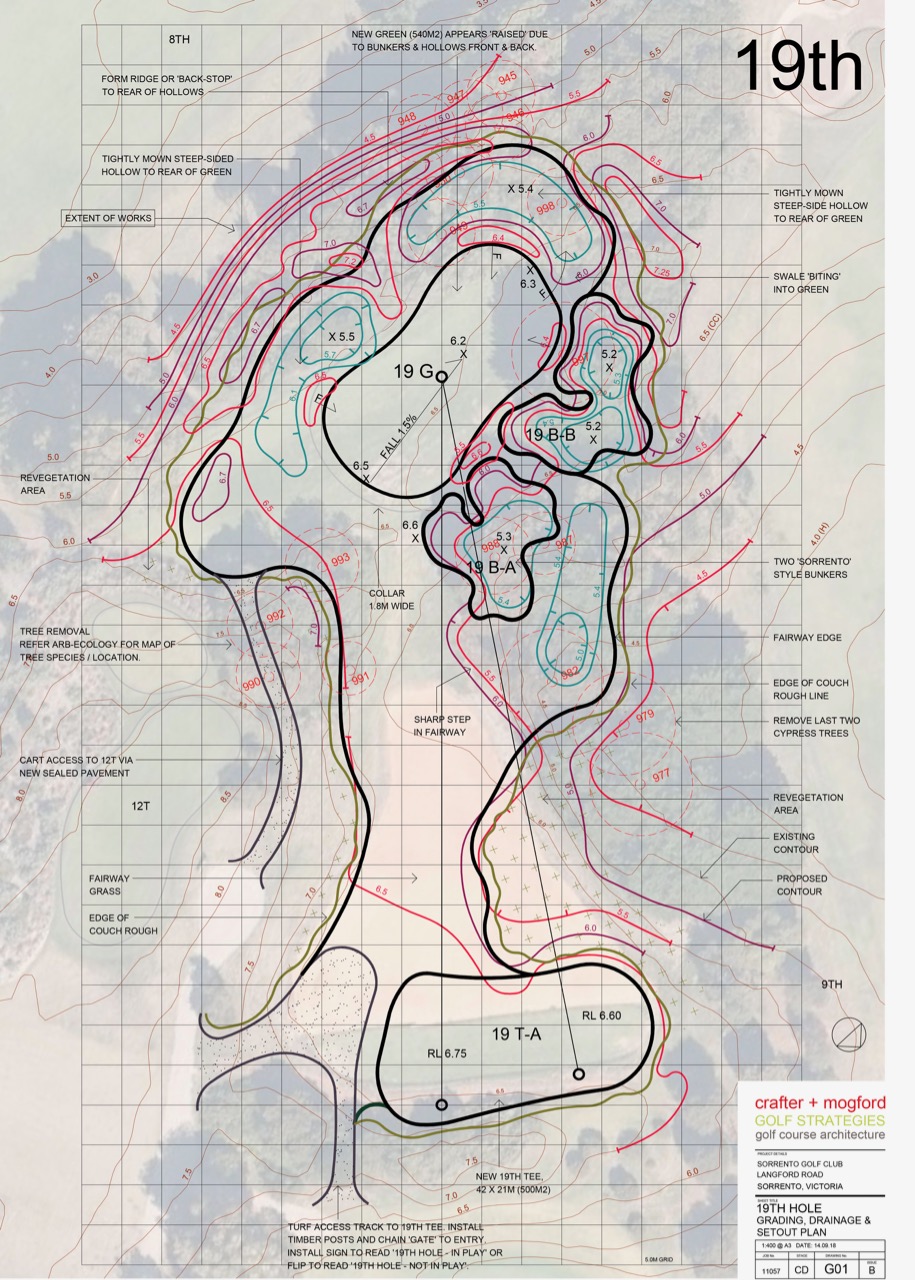 Sorrento GC- new19th hole
Sorrento GC- new19th hole
The natural soil type of a site is of great importance and here sand is king!
It is free draining and requires little in way of additional subsurface drainage and or surface drainage collection points.
Sand provides significant freedom to shape the surface contours, however, often the best approach is to protect the natural characteristics of the existing ground as this can help distinguish one course from another.
The ability to read and understand contours on a topographical map is an important skill for the budding golf course architect.
Being able at a glance to distinguish a site’s ridges from its valleys, it’s peaks from its depressions, is vital and understanding that the closer together contour lines are together, the steeper the slope.
View lines from projected tees to landing areas and from landing areas to greens are crucial as no-one will enjoy a course filled with blind tee shots and blind approaches.
Safety:
The routing of holes must consider the safety of courses boundaries as well as the internal safety of other golfers and users of the property.
External boundaries.
Architects are careful to lay out holes so as to not endanger interfacing land-uses such as adjoining roads, housing and other public open space.
Where possible holes are laid out with the slice side (for right-handers) internal.
In addition, sufficient setback must be provided between the desired centre-line of play and the boundary to allow for errant play.
This buffer distance varies between architects however 60-70 metres from a typical drive landing length is common, however, this can be less for short par 3s.
Environmental factors such as elevation change from the teeing ground to the landing area and prevailing winds also need to be considered and factored in to buffer distances.
Vegetation, used as a buffer, should not be relied upon as vegetation is not long lasting.
Internally the relationship between tees, greens and fairways must also be considered to provide appropriate safety of golfers and maintenance staff.
For example, the centre-line of fairways of two parallel holes should be at least 60 metres apart, however, there are many factors which affect this basic guideline.
Landscape:
Harmony with the surrounding landscape is the objective.
This principally takes the form of merging with the borrowed landscape of a site.
This is apparent in the scale and form of the shapes of the land and in general terms the course shaping and features should also reflect this.
For example, a bold and undulating dune site will support a similarly bold bunker style.
The opposite may be the case for a flatter site where a more subdued bunker style can be most appropriate.
The natural vegetation of the surrounding area is of significance.
Imposing an exotic vegetation type is less sustainable and should be avoided.
Using species endemic to the site, or region, protects the genetic gene pool of plants and supports the diversity of the area as well as provides appropriate habitat for native fauna.
It is also less expensive to establish and maintain over the longer term.
In summary, to conceive and realise one’s design for a golf hole is a rewarding experience.
It can be fraught and the anticipation of how it is received can be rather interesting!
It may not be obvious, but successful golf course design requires a team of talented people all working towards a common outcome.
From the shaper’s skill to interpret the architect’s plans and the construction crew’s dedication to install the drainage, irrigation and undertake the fine-shaping, it is a hugely collaborative affair.
It is an organic process – and an art form in many ways.
Paul Mogford
Golf Architect
Crafter & Mogford Golf Strategies
see also: How to play a golf hole:
Golf Tours
The Travelling Golfer offers golf tours to the great golfing destinations
We can tailor a trip to suit your group or you can join one of our small group escorted tours.
For suggested itineraries see: Golf Destinations
Enquiries
Please enquire here:

